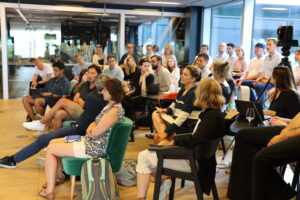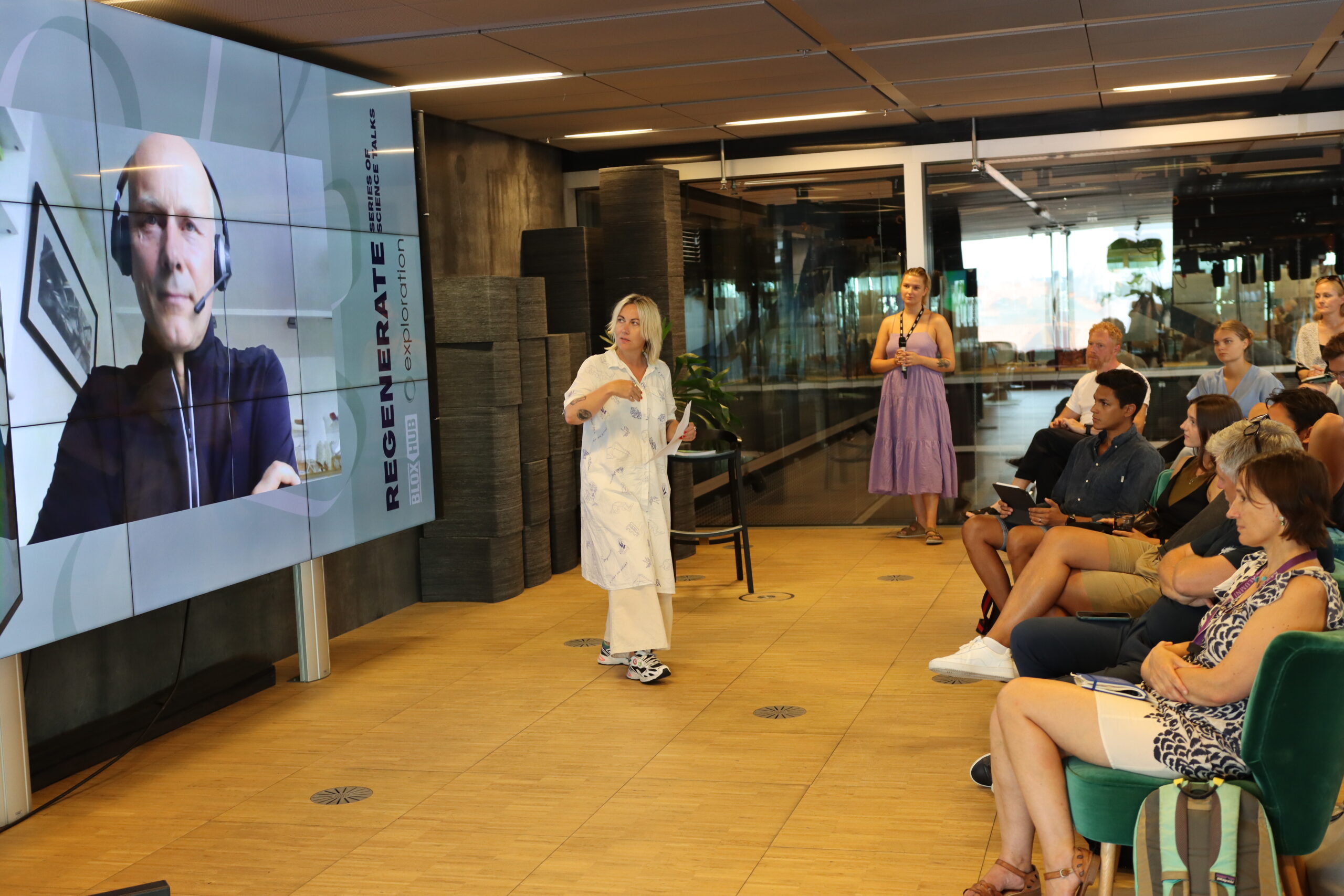At the latest Science Talk, British architect Michael Pawlyn explained the differences between sustainability and regenerative approaches and argued for biomimicry as a source of solutions for the crises facing the planet.
At the first Science Talk after the summer break, British architect and founder of Exploration Architecture Michael Pawlyn joined us virtually from London. He has been described as an expert in regenerative design and biomimicry, and many people had turned up at BLOXHUB and online to hear his take on the current crises facing the planet and the solutions needed to counter them.
In the talk, Michael Pawlyn elaborated on the difference between sustainability as it has been practiced in the built environment up until today and the regenerative approach, which is gaining traction in many different sectors now. Through examples from his work, he showed how biomimicry and learning from nature can be a source of solutions for the climate and biodiversity crises and touched upon the theme of politics and systems change.
Gaining Perspective
To start out the talk, Michael Pawlyn sketched out the human impact on the planet by making a comparison: Imagine the history of planet Earth until now as a calendar year and that we’re now at a breath before 12 o’clock on New Year’s Eve, looking back. The first few months of the year were very quiet – the first life forms didn’t show up before March. The dinosaurs arrived around mid-December and went extinct on December 25th.

Many people had turned up at BLOXHUB and online to hear Michael Pawlyn’s Science Talk on the regenerative approach.
Humans did not arrive until eight in the evening on New Year’s Eve, and the whole of recorded history has flashed by in the last thirty seconds before midnight. “In the last two seconds, humans became a geophysical force altering our climate, and in the last third of a second we’ve extinguished 2/3 of wildlife on planet Earth,” says Michael Pawlyn, but continues that it is also during this last third of a second that we’ve mastered solar energy and developed “phenomenal” scientific knowledge and “unparalleled” technology: “What we do in the next tenth of second will determine to a large extent the future of humanity,“ he says.
This is also why, according to him, it is no longer enough to talk about sustainability. Sustainability has been different levels of being less bad, and “it hasn’t gotten us anywhere near where we’re supposed to be,” he says. What we need to do is reach a positive realm, where we contribute actively to ecosystems and the environment, giving more than we’re taking. That is what the regenerative paradigm is about, and that is what is needed to counter the damage we’ve done to the planet and its many different lifeforms.
“We need to get into the realms of having a positive impact and ultimately getting to the point where we have overcome our separation from nature, and we are coevolving as part of nature. I’m convinced that a lot of the solutions, we’re going to need, are to be found in biomimicry and indigenous design,” says Michael Pawlyn.
Different Regenerative Levels
To bring out different examples of what the regenerative paradigm looks like in the built environment, Michael Pawlyn gives four main headings: Regenerative landscapes, cities, buildings, and materials.
For regenerative landscapes, Michael Pawlyn elaborates on the Sahara Forest Project, a project he joined in 2007. In this project, the use of solar power, revegetation, and a greenhouse that is cooled by seawater and produces freshwater in the process was part of the regenerative solution. Within the first days and months after the opening of the facility, the team saw wild birds and insects return to the place, they’d long deserted, even though it was far away from other habitats, which was quite remarkable according to Michael Pawlyn: “Nature seems to have an ability to regenerate if you just create the right conditions,” he says.
When it comes to cities, the important thing is to look at the place where it’s located: How would a mature, pristine ecosystem in that part of the world function? How much oxygen would it produce, how much carbon would it sequester, how much wildlife would it accommodate, and how much food would it produce? Those should become the metrics of the city, and by reaching that point one could argue that the city is an integrated part of the existing ecosystem – not a disrupter, as is often the case.
City systems should also be zero-waste, where the resource flows feed into one another – the output from one system should be the input for another. Furthermore, Michael Pawlyn highlighted the many advantages of incorporating more vegetation into city design, like creating habitats for animals, the positive impact on health, more cooling, and the freeing up of space.
For buildings and materials, Michael Pawlyn brought examples from his own work, including an office building whose lighting system had been inspired by the way the eyes of a spook fish reflect and redirect light, and taking inspiration from natural structures such as bird skulls and seashells to learn how to use resources more efficiently, as well as organisms such as corals which create material out of carbon – learning that technique could thus help solve emission problems.
For more details and project examples find the link for the entire Science Talk at the bottom of the article.
To Bring About Change
A central towards the end of Michael Pawlyn’s talk was that just focusing on a single project or even on the built environment isn’t enough. To really make the shift to a regenerative approach, there must be a system change. This means changes to people’s mindsets, to politics and economics.
According to Michael Pawlyn, it has been argued that the shift hasn’t happened, because we haven’t yet got the skills and solutions for it. This is not true, he says: “We’ve had the skills and solutions for quite a long time, but there is one thing that is still fundamentally missing. We need to show that we are adding public demand. With the combination of solutions, skills, and public demand we can overcome the resistance to these solutions,” he says and adds that there has been a lot of complacency among politicians and to some extend mass media, and that they have been very reluctant to show leadership on climate change.
Michael Pawlyn is also one of the organizers behind Architects Declare – an initiative to bring about change on a political level, which has gained signatories from more than 7000 organizations in the built environment and spread out to many different countries. According to him, we need to show this public demand in several ways like these, and also points to initiatives such as Fridays for Future. “We really urgently need to bring about a tipping point so all these solutions can flourish,” he says and continues:
“The regenerative approach also points to a new relationship with biology. For far too long we’ve had a dualistic perspective on nature. We’ve seen nature as something separate from us, and as something that can be plundered for resources. We need to see it now not just as a source of wonder, but as a source of some of the best solutions, that can help us design solutions fit for the future.”
Watch the entire Science Talk on our YouTube to learn more about Michael Pawlyn’s projects, the potential of biology to solve our crises, and what we need in order to make the change to a regenerative approach.
You can also read our interview with Michael Pawlyn.
All Science Talks of 2022 have the theme “Regenerate”, which you can read more about in this interview with one of the industrial researchers from our Circular Built Environment Network. Stay updated on upcoming talks in our event calendar.



